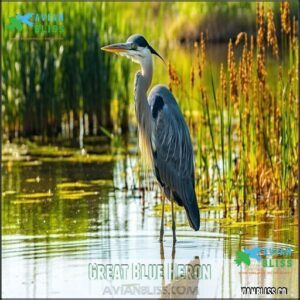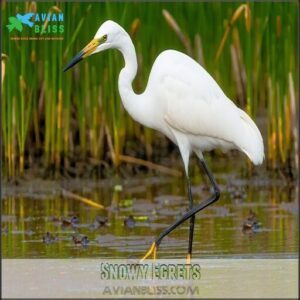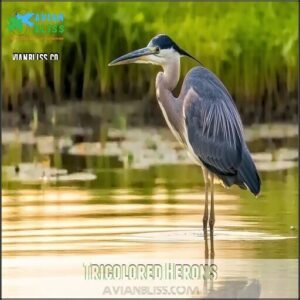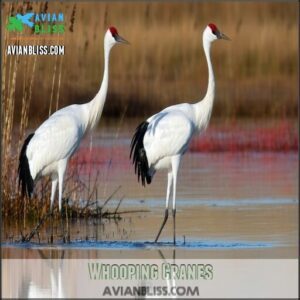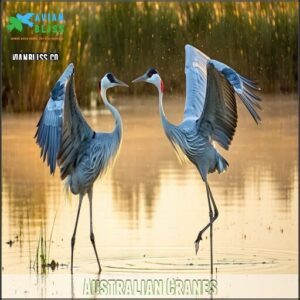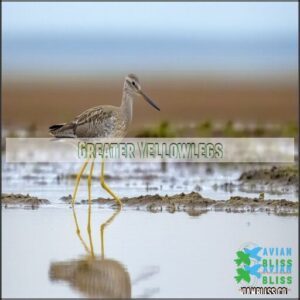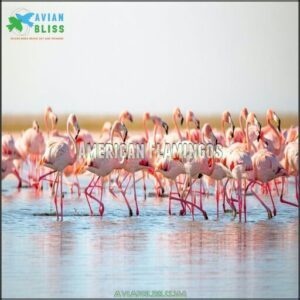This site is supported by our readers. We may earn a commission, at no cost to you, if you purchase through links.

Their elongated legs aren’t just a fashion statement—they let these birds wade through water without soaking their feathers, keeping them dry and light.
Long toes help them balance on muddy surfaces, while their sharp eyesight and quick beaks make catching food look effortless.
Flamingos even get their pink color from the algae they eat, and from the graceful stride of a heron to the synchronized movements of flamingos, these birds thrive in some of nature’s messiest habitats, with their ability to survive these settings so effortlessly.
Curious how they survive these settings so effortlessly?
Table Of Contents
- Key Takeaways
- Birds With Long Legs
- Wading Bird Families and Feeding Methods
- Notable Long-Legged Bird Species and Habitats
- Migration and Breeding Adaptations
- Conservation Efforts for Long-Legged Birds
- Frequently Asked Questions (FAQs)
- Why do birds have long legs?
- Do egrets have long legs?
- Are there any birds with long legs in North America?
- What is a bird with long legs?
- Are hummingbirds long legs?
- What kind of bird has long legs?
- What is a grey bird with long skinny legs?
- What kind of bird has long legs in the pond?
- What are the black and white birds with long legs?
- What bird is known for its long legs?
- Conclusion
Key Takeaways
- You’ll notice long-legged birds thrive in wetlands, using their legs to wade through water, keep feathers dry, and hunt efficiently.
- They rely on specialized physical traits, like wide toes for balance and sharp eyesight, to adapt to muddy, slippery surfaces.
- Species like herons, flamingos, and egrets showcase varied diets, striking plumage, and unique behaviors like filter-feeding or elegant mating dances.
- Protecting ecosystems is critical for these birds’ survival, as habitat loss and pollution threaten their ecosystems.
Birds With Long Legs
You’ve probably noticed how some birds, like herons and flamingos, have impressively long legs perfectly suited for their wetland homes.
These legs help them wade through shallow waters, keeping their feathers dry while reaching food that’s out of reach for others.
They are perfectly suited for their environment.
Physical Adaptations for Wetland Navigation
Ever wonder how longlegged birds glide effortlessly through wetlands?
Their bird leg anatomy is fascinating! Built for wading depths, they’ve got leg length that keeps their feathers dry, while toe structures spread wide to avoid sinking.
Add in ankle flexibility, and wading birds silently stalk prey in aquatic habitats.
Their bird leg adaptations even include waterproof scales for protection.
It’s as if nature designed these wading birds with custom-fit gear for marshy adventures—great balance, zero soggy feathers!
Role of Legs in Balance and Stability
Longlegged birds have evolved impressive leg structures for maintaining balance. Their wide leg bases act like natural tripods, distributing weight evenly and providing steady grounding, even on slippery mud.
Long-legged birds stand like natural tripods, mastering balance and stability even on slippery, muddy surfaces.
Specialized joints "lock" legs into position, making long periods of standing a breeze. With strength like stilts, their legs stabilize movement as they wade or hunt.
These birds often forage in shallow aquatic habitats, which their long legs allow. This unique bird leg function showcases nature’s clever designs for posture and balance—poise that’s practical and impressive.
Species-Specific Traits and Plumage
You’ll notice wading birds boast stunning plumage variation and features that help with bird identification.
The American Bittern’s streaked browns blend seamlessly into marshes, while the Scarlet Ibis flaunts a fiery red, perfect for standing out.
Snowy Egrets shimmer white, their yellow feet acting like spotlight shoes.
Juvenile plumage often lacks vibrant tones, making younger birds harder to spot.
Size differences, leg coloration, and unique mating displays add intrigue to these fascinating bird species, with their stunning features.
Wading Bird Families and Feeding Methods
You’ll find that wading birds, like herons, flamingos, and storks, have incredibly specialized feeding techniques suited to their habitats.
From spearing fish with sharp beaks to filtering tiny organisms through unique bills, their methods are as fascinating as they’re effective.
Herons, Egrets, and Bitterns
The heron family is full of fascinating wetland predators, each with unique abilities.
You might find a Great Blue Heron frozen like a statue, suddenly launching into a precise strike—classic heron hunting. Egret types, such as the Great Egret, shine with their snowy plumage and spear-like bills used for fishing.
Bitterns, masters of camouflage, blend seamlessly into reeds, showcasing their striped patterns.
These birds thrive near water, nesting in colonies high in trees. Notably, they fly with their S-shaped necks pulled back—a distinctive trait.
- Great Egret’s brilliant plumage changes during breeding.
- Bitterns vanish into marshes using clever camouflage.
- Habitat loss sparks conservation efforts globally.
Cranes and Storks
Cranes and storks, though both long-legged, boast distinct traits.
Cranes, like the Whooping Crane and Sandhill Crane, showcase vibrant plumage and engage in elegant dances to woo mates.
Stork birds, majestic yet sturdier, rely on their thick bills and clattering communication.
You’ll find cranes thriving in wetlands, while stork migration often spans continents.
Their nesting habits reflect wetlands’ importance, as healthy ecosystems sustain both.
With unique leg structures and graceful behavior, these iconic species reflect their conservation status and cultural significance worldwide.
Flamingos and Spoonbills
Flamingos and spoonbills add vibrant color to wetlands with their pink pigmentation. These birds don’t hog the spotlight—they’re experts in filter feeding and using unique bill morphology for survival. American Flamingos, with their curved beaks, sift tiny crustaceans and algae, while Roseate Spoonbills, and their Australian cousins, Yellowbilled Spoonbills, sweep spoon-shaped bills to detect prey.
As wetlands are essential, protecting these habitats is vital for their survival.
Here’s how they thrive despite habitat loss:
- Unique foraging techniques aid survival.
- Bird leg use in foraging extends reach.
- Social behavior: thrive in flocks.
- Pink diets provide camouflage.
- Adaptable homes, from mangroves to marshes.
Notable Long-Legged Bird Species and Habitats
You’ll find some of the most striking long-legged birds in wetlands, marshes, and even along coastlines, each adapted perfectly to its environment.
From the elegant Great Blue Heron to the vibrant Scarlet Ibis, these species showcase nature’s ingenuity in balancing form and function.
Great Blue Heron
Standing at 4.5 feet tall, the Great Blue Heron is one of the most striking members of the heron family.
These wading birds, with their blue-gray feathers and sharp "daggerlike" beaks, are masters of shallow water hunting strategies.
Their habitat range spans North America’s marshes, rivers, and coastlines, where they use their long legs to stalk fish and amphibians.
Known for their calm social behavior, they often stand silently, blending into their surroundings.
Here’s a quick snapshot of this elegant bird:
| Feature | Details | Fun Fact |
|---|---|---|
| Height | Up to 4.5 feet | Comparable to a kindergartner |
| Wingspan | Up to 6.6 feet | Larger than many humans! |
| Diet | Fish, frogs, small mammals | Expert at patiently waiting |
| Conservation Status | Least Concern | Thriving in protected habitats |
Flamingos
From the elegance of the Great Blue Heron, we glance at flamingos—charismatic showstoppers of the bird world.
These birds with long legs are marvels of nature.
- Eye-catching pink coloration comes from their crustacean-rich diets.
- An upside-down beak structure helps filter-feed algae and brine shrimp.
- They thrive in lagoons but face habitat threats.
- Social behavior includes thousands-strong colonies.
The rare American Flamingo highlights Florida’s saltwater wetlands, embodying beauty and adaptation.
Snowy Egrets
Snowy Egrets, iconic members of the wading birds family, captivate with their pristine white plumage and standout “golden slippers” – yellow feet that contrast vividly with their black legs.
These medium-sized birds, about 24-26 inches tall, thrive in wetlands, showcasing lively foraging techniques to hunt for fish, frogs, and a crustacean diet.
Once nearly extinct due to historical hunting for their breeding plumage, they’ve made a remarkable comeback, even adapting to urban environments for coastal breeding, which is a notable example of their ability to survive in various wetlands.
Tricolored Herons
Graceful yet lively, the Tricolored Heron dazzles with its blue-gray, lavender, and white plumage, accented by a white belly and a striped neck.
Found in coastal habitats, these wading birds rely on quick moves and sharp instincts.
Their foraging behavior includes chasing fish or trailing cormorants to nab disturbed prey.
During breeding plumage, stunning feather hues intensify, and their varied diet includes small fish, amphibians, and crustaceans, reflecting adaptability within bird habitats.
Scarlet Ibis
In lush mangrove habitats, the Scarlet Ibis dazzles with its scarlet plumage, a reflection of its diet rich in crustaceans.
These birds with long legs expertly navigate muddy waters, foraging for small fish and invertebrates.
Sharing nesting duties, both parents rear chicks whose feathers slowly transform into vibrant red.
Despite their striking beauty, habitat threats like pollution and poaching challenge their survival, emphasizing the need for conservation to protect their unique habitats.
Migration and Breeding Adaptations
You’ll notice that birds with long legs, like cranes and flamingos, rely on these unique features for efficient migration and specialized breeding behaviors.
Their tall frames and adaptable habitats help them travel vast distances and create safe nesting sites, ensuring their survival and future generations.
Whooping Cranes
Standing tall at 5 feet, the endangered Whooping Crane captivates with striking white feathers and black wingtips.
These tall birds migrate 2,500 miles annually between Canada and Texas, exemplifying their unique bird migration patterns.
Once down to 15 individuals, they now number 500 thanks to reintroduction programs.
**1. Each journey reflects their habitat needs and genetic diversity, reminding us of the critical role of bird conservation.
Sandhill Cranes
You witness Sandhill Cranes’ migration, with nearly half a million gathering at Nebraska’s Platte River valley.
They perform elaborate dances, strengthening pair bonds. Their gray feathers and distinctive red crown make them easily identifiable.
| Crane Species | Migration | Habitat Needs |
|---|---|---|
| Sandhill Crane | Long-distance | Wetlands |
| Whooping Crane | Endangered | Conservation |
| Common Crane | Migratory | Grasslands |
| Demoiselle Crane | Long-distance | Steppes |
| Red-crowned Crane | Endangered | Wetlands |
Australian Cranes
In Australia’s wetlands, the Brolga and Sarus Crane dazzle with their mesmerizing "Brolga Dance."
These striking Australian cranes, among the tallest birds with long legs, rely on their limbs for graceful movement and courtship displays.
The Sarus Crane, the world’s tallest flying bird, and the Brolga both face challenges from habitat loss.
Conservation efforts aim to protect wetland ecosystems essential for their unique behaviors, and their whooping calls echo across Queensland, reminding us of their fragile conservation status.
Greater Yellowlegs
The Greater Yellowlegs is a shorebird with bright yellow legs you can’t miss.
This medium-sized bird migrates yearly between Canada’s wetlands and U.S. coasts, showcasing its adaptability. You’ll spot its mottled grey-brown feathers, long dark bill, and distinctive white rump patch flashing mid-flight.
Known for its loud, clear calls, the Greater Yellowlegs’ voice makes identification a breeze.
- Key traits: bright yellow legs, long bill
- Range: Canada to U.S. coasts
- Diet: small aquatic creatures
- Migration patterns: seasonal, vast distances
- Foraging techniques: wades in shallow water
American Flamingos
American Flamingos, iconic birds with long legs, gather in vast colonies, timing mating rituals with rainfall.
Their famous Flamingo filtration technique enables them to feed on algae and plankton.
Though their vibrant plumage wows, they face habitat loss. Conservation status efforts aim to protect chick rearing and sustain wading flocks for future generations, using their distinct bird leg structure to wade through hypersaline lagoons.
Conservation Efforts for Long-Legged Birds
You can make a difference in protecting long-legged birds by understanding the threats facing their wetland habitats, from pollution to habitat loss.
Conservation efforts focus on preserving biodiversity and ensuring iconic species like the Whooping Crane continue to thrive for generations to come.
Threats to Wetland Habitats
Long-legged birds face tough challenges as wetlands disappear faster than you’d expect.
From pollution impacts like pesticide-filled runoff to habitat loss caused by draining marshes for urban sprawl, these changes hit bird populations hard.
Climate change also stirs trouble, shifting water levels and reshaping wetlands. On top of that, invasive species muscle out native plants, throwing ecosystems out of balance.
Picture fewer herons or flamingos—no graceful silhouettes at sunset.
Fighting bird habitat loss means supporting conservation strategies like wetland restoration to reverse bird population trends and protect endangered landscapes for future generations. Supporting bird habitat projects can substantially aid these efforts.
Protecting Iconic Species
When iconic birds like the American Flamingo, Whooping Crane, or Roseate Spoonbill face threats from pollution or climate change, you’re helping more than just birds by supporting conservation.
Habitat restoration transforms damaged wetlands into thriving ecosystems, while reducing invasive species safeguards native balance.
Legal protections and pollution reduction laws work overtime to protect species like the Jabiru and Wood Stork. Habitat loss impacts these vulnerable populations.
Public awareness, combined with sustainable tourism, funds these efforts, preserving the beauty of wetlands and guaranteeing these birds can wade freely for generations, which is crucial for their long-term survival.
Preserving Bird Biodiversity
To protect long-legged birds—and the ecosystems they call home—it’s key to focus on their survival as a collective effort.
Here’s how you can start making a difference:
- Habitat Restoration: Rebuild wetlands to give birds places to feed, nest, and thrive. Consider using wetland habitat products for restoration projects.
- Pollution Reduction: Clean waterways and reduce plastic waste to keep their habitats safe.
- Address Climate Change: Support sustainable practices to minimize disruptions caused by a warming planet.
- Community Engagement: Get involved locally by educating others and funding conservation projects.
By protecting bird diversity, you’re preserving nature’s rich, irreplaceable symphony.
Frequently Asked Questions (FAQs)
Why do birds have long legs?
Birds have long legs to wade through water, search for food, or run swiftly on land.
It’s all about adaptation—they’re built to thrive in their habitats, whether hunting prey or escaping predators.
Do egrets have long legs?
Did you know egrets can reach nearly 3 feet tall?
That’s because they’ve got long, elegant legs, perfect for wading through shallow waters.
These legs help them hunt fish, frogs, and insects with ease!
Are there any birds with long legs in North America?
You’ll find plenty of long-legged birds across North America.
Think Great Blue Herons striding through wetlands, Flamingos wading gracefully, or lanky Whooping Cranes crossing marshes.
Their legs aren’t just for show—they’re built for survival.
What is a bird with long legs?
Imagine legs taller than some small pets—like the Great Blue Heron’s, standing up to 5 feet tall.
These waders use their long legs to stalk shallow waters, catching fish with precision and grace.
Are hummingbirds long legs?
Hummingbirds don’t have long legs.
Their legs are tiny and mainly used for perching, not walking or wading.
These birds are built for speed and hovering, not striding through water like a heron or flamingo.
What kind of bird has long legs?
With legs like stilts, birds such as herons, flamingos, and ibises wade gracefully in wetlands.
These long legs help them hunt fish, insects, and frogs while staying dry and nimble in their watery habitats.
What is a grey bird with long skinny legs?
A grey bird with long, skinny legs might be a Great Blue Heron or a Black-crowned Night Heron.
These wading birds use their slender legs to navigate wetlands gracefully while hunting fish, frogs, and insects.
What kind of bird has long legs in the pond?
You’re likely spotting a wading bird like a heron, egret, or even a flamingo.
These birds use their long legs to gracefully navigate shallow waters, hunting fish, frogs, or invertebrates without wetting their feathers.
What are the black and white birds with long legs?
They’re likely black-and-white stilts, strikingly elegant wading birds often spotted in wetlands or ponds.
These beauties use their slender, long legs to tiptoe through shallow water, foraging for insects, crustaceans, and tiny aquatic creatures, which makes them a fascinating sight in their natural habitat with their elegant appearance.
What bird is known for its long legs?
The flamingo is famous for its long legs, which are even longer than its body.
They use these elegant limbs to wade through water, filter-feeding on algae and crustaceans while showing off their signature grace.
Conclusion
Imagine spotting a Great Blue Heron gliding effortlessly across a marsh, its long legs slicing through the water with precision.
Birds with long legs thrive in wetlands because their unique adaptations help them balance, wade, and hunt efficiently.
From the flamingo’s vibrant pink hues to cranes’ epic migrations, these species showcase nature’s ingenuity.
Wetlands are essential to their survival, so protecting these habitats guarantees that we preserve the elegance and ecological role of these fascinating creatures.
- https://www.allaboutbirds.org/guide/Roseate_Spoonbill/id
- https://en.wikipedia.org/wiki/Whooping_crane
- https://www.fws.gov/press-release/2023-05/2023-wintering-whooping-crane-count
- https://globalbirdinginitiative.org/birds-with-long-legs/
- https://www.rspb.org.uk/birds-and-wildlife/natures-home-magazine/birds-and-wildlife-articles/how-do-birds-survive/birds-legs-and-feet/


